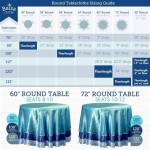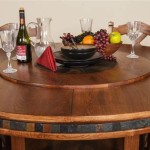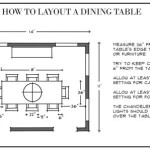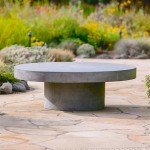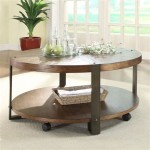Are Round Dining Tables Better For Small Spaces Than Rectangular Ones?
Choosing the right dining table for a small space can be a considerable challenge. The selection impacts not only the room's functionality but also its aesthetic appeal and perceived spaciousness. A common debate among interior design enthusiasts and homeowners centers around whether round dining tables are a superior choice compared to rectangular ones in limited square footage environments. This article examines the arguments for and against round tables in small spaces, aiming to provide a comprehensive understanding to aid in making an informed decision.
Space Efficiency and Traffic Flow
One of the primary arguments in favor of round dining tables for small spaces lies in their potential to improve space efficiency and facilitate smoother traffic flow. Rectangular tables, with their sharp corners, often require a larger clearance area to avoid obstructions and allow for comfortable movement around the table. In contrast, the absence of corners in a round table enables a more streamlined movement pattern. Individuals can navigate around a round table more easily, minimizing the risk of bumping into sharp edges, which is particularly beneficial in tight spaces. The circular shape can visually open up the room, creating a perception of greater spaciousness compared to the linear footprint of a rectangular table.
Furthermore, the space-saving benefits are often magnified in awkwardly shaped rooms. When a room lacks perfect square or rectangular dimensions, positioning a rectangular table can create unused and inaccessible corner spaces. A round table, however, can adapt more readily to irregular room layouts, maximizing the usable area and leading to a more cohesive and functional design. The continuous curve of the table allows for a more forgiving arrangement, minimizing the visual clutter associated with trying to force a rectangular shape into an unsuitable space.
However, the space efficiency of a round table depends largely on its diameter and the number of occupants it's intended to accommodate. A round table with a diameter that is too large can actually consume more floor space than a smaller rectangular table. Therefore, careful measurement and consideration of seating needs are crucial when evaluating the suitability of a round table for a specific small space. If the table is too big, it negates the advantages of its shape. It is important to remember that the usable surface area of a round table also diminishes as the diameter increases, as items placed in the center become harder to reach. The practical benefits of enhanced traffic flow are lost if the table itself overwhelms the room.
Intimacy and Social Interaction
Beyond spatial considerations, the shape of a dining table plays a significant role in influencing the dining experience. Round tables are widely recognized for fostering a more intimate and inclusive atmosphere. The circular configuration allows all diners to face each other, promoting eye contact and facilitating conversation. This arrangement encourages a sense of equality and connection, making round tables particularly well-suited for smaller gatherings or families who prioritize direct communication during meals.
In contrast, rectangular tables, especially larger ones, can create a more formal and hierarchical setting. Individuals seated at the ends of the table may feel somewhat disconnected from those at the opposite end. This can be less conducive to casual conversation and a more relaxed dining experience, particularly in a small space where the emphasis is often on creating a cozy and welcoming ambiance. The compact nature of a round table naturally encourages interaction and makes it easier for everyone to participate in the conversation, enhancing the overall social experience.
However, the advantages in intimacy are limited by the size of the round table. As the diameter increases to accommodate more diners, the benefits of enhanced interaction begin to dissipate. Individuals seated on opposite sides of a large round table may find it difficult to maintain eye contact and comfortably engage in conversation. In these scenarios, the social advantages of a round table may be negated, and a well-proportioned rectangular table might provide a more practical solution. Furthermore, for formal dinner parties or situations where clear hierarchies are desired, the equal footing provided by a round table may be less desirable than the head-of-table dynamic inherent in a rectangular configuration.
Aesthetic Considerations and Design Style
The decision between a round and rectangular dining table also involves a careful consideration of aesthetic preferences and the overall design style of the room. Round tables often possess a softer, more organic aesthetic that can complement a variety of design styles, from minimalist and contemporary to bohemian and traditional. The curved lines of a round table can introduce a sense of fluidity and grace to a small space, softening the hard edges and corners often present in smaller rooms. This can create a more inviting and visually harmonious environment.
Rectangular tables, on the other hand, tend to exude a more formal and structured aesthetic. They can be particularly well-suited for contemporary or modern spaces that emphasize clean lines and geometric shapes. A rectangular table can create a sense of order and stability, anchoring the dining area and providing a strong visual focal point. In certain design schemes, the sharp lines of a rectangular table may be more desirable than the softer curves of a round table.
Ultimately, the aesthetic suitability of a round or rectangular table depends on the specific design vision for the space. Factors such as the existing furniture, color palette, and architectural features should be taken into account. The scale and proportions of the table should also be carefully considered to ensure that it complements the overall aesthetic without overwhelming the room. For example, a small, delicate round table might be appropriate for a cottage-style dining area, while a sleek, minimalist rectangular table might be a better fit for a contemporary apartment.
In addition to the primary shape, other design elements impact the perceived size and aesthetics of the table within the room. The material, such as glass, wood, or metal, influences the visual weight. The table's legs and base also contribute to the overall impression, with styles ranging from pedestal bases to thin, modern legs. Consider these components alongside the table’s shape to achieve the optimal blend of form and function within the limited space.
The versatility of each shape should also be considered. Rectangular tables can often be extended with leaves to accommodate larger gatherings, making them adaptable to varying needs. Some round tables may also offer extendable features, but this is less common. The ability to transform the table size depending on the occasion presents a significant advantage for those who frequently entertain in their small space. In contrast, round tables can often be pushed against a wall when not in use, effectively creating more space, a trick that is usually more difficult with rectangular tables.

Why A Round Dining Table Might Be Your Best Option Abide Interiors
15 Best Dining Tables For Small Spaces

19 Small Dining Room Ideas And Decorating Tricks For 2025

Rules Of Thumb For Rugs Under Round Dining Tables Inspiration

7 Stylish Dining Tables That Are Perfect For A Small Space Taskers

Rules Of Thumb For Rugs Under Round Dining Tables Inspiration

Conrad Extension Dining Table Herringbone Detail

11 Small Dining Space Ideas One Brick At A Time

Rules Of Thumb For Rugs Under Round Dining Tables Inspiration

Top 12 Dining Room Trends For 2025 According To Designers
Related Posts


